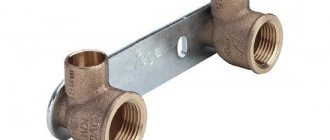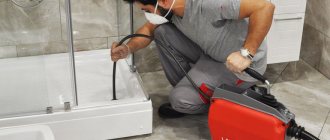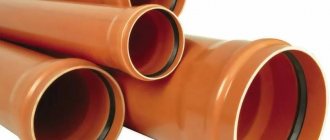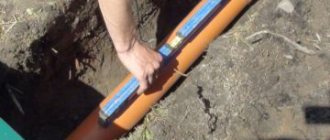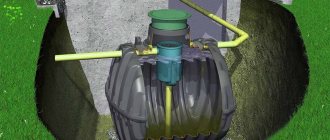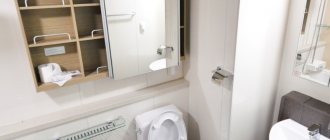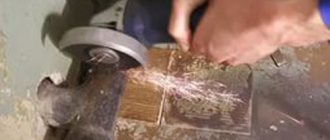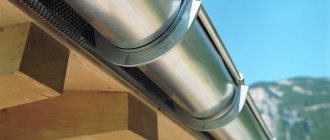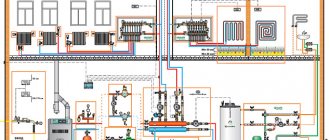The traditional solution for removing domestic water and sewage from a home is a gravity sewer system, in which waste, driven by gravity, flows and moves through pipes laid with a slope of at least 2%. From the plumbing fixtures they move to the riser, from where they are discharged into the external sewage system and redirected to a bio-treatment plant or another treatment facility. Nowadays, forced sewerage is increasingly helping to free up the hands of designers and homeowners. Pipes for waste disposal in the presence of a sololift have a very small diameter (from 16 to 45 mm), and the sololifts themselves have small dimensions and are easily hidden in the wall.
Manufacturers and models
Not many companies produce individual sewerage installations. However, the price range is quite wide. Traditionally, European manufacturers are distinguished by good quality, but high prices. No one will be surprised if we say that Chinese sewage pumps cost less, but their quality is worse. In general, the choice, as usual, is expensive and high quality, or cheaper and...
Forced sewerage installations Grundfos (Grundfos) - Sololift (Sololift)
The well-known manufacturer of plumbing fixtures Grundfos produces Sololift pumps for forced sewerage. At the moment, a modified Sololift2 line has been launched. There are no moving parts in contact with drains. The exception is the chopper, but its drive is also “dry”. This makes repairs less of a hassle. There are several Sololift models for different cases:
Sololift sewer pumps are not the cheapest equipment, but they work reliably and meet the stated characteristics. The company also supports warranty repairs.
Pumps for toilets, bathrooms, kitchens and technical rooms SFA
This company specializes in the production of sanitary pumps. There are several lines to solve different problems and connect various devices:
SFA products work reliably and cost slightly less than Grundfus. You can choose a model for any combination of plumbing fixtures. Overall, the SFA sewage pump is a good option. Equipment installation is standard - place it in any convenient place. There is only one limitation - it is better for the outlet pipeline to start from a vertical section, if there is one on your route. If this is not possible, the length of the horizontal section should be no more than 30 cm.
The height of the vertical section is calculated taking into account that the horizontal section must have a slope towards the inlet of at least 1% (1 cm per 1 meter of pipe).
CompactLift fecal pumps from Aquatik
Toilet pumps Compact Lift are produced by the Chinese company Aquatic. This is a more budget-friendly option for individual sewer installations. They have a low noise level.
At the moment there are only three modifications:
Aquatik provides a warranty on its pumps for bathrooms and toilets for 1 year from the date of sale. Failure to operate (presence of fibrous inclusions in drains) may result in refusal of warranty repair.
Willo sewage pumps
The German company Willo is known for producing reliable devices. Toilet pumps are no exception. Good quality plastic, thick tank walls, reliable pump. The following models are available:
The Willo range of sewer pumping units allows you to solve any problem when it comes to equipping bathrooms and toilet rooms in private homes. For commercial or more intensive use, Willo has other solutions.
Pressure sewage pumps STP (Jemix)
These custom sewer installations are manufactured in China. The price category is average. Reviews, as usual, are different - some are completely satisfied, others categorically dislike it.
So, here are the sewerage pumps Jemix offers:
It differs from those described above in its increased power - some models raise drains by 9 meters. Most of the sewerage pressure pumps described above can lift wastewater up to 4-5 meters. So this is where the Jamicks win. In this parameter they have only one competitor - Sololift Grundfos with its lifting height of 8 meters. But its price category is completely different (as is its quality, for that matter).
Leaks
Sewer leaks in the basement can also occur in addition to blockages - due to a violation of the tightness of the pipes themselves and their connections.
Symptoms
Drains flow onto the basement floor through the flared connection of the bench, through the riser from the ceiling between the basement and the first floor, or through a break in the pipe.
Causes
- Caulking the socket of a cast iron sewer;
In the photo there is a leak in the hammered socket of the bedspread
- Pipe subsidence in the ceiling. In this case, the sealing of the socket is again broken;
- Destruction of a socket or pipe under deforming loads;
Incorrect fastening of the pipe (large step between hangers) led to the appearance of a crack
- Destruction or loss of elasticity of the sealing ring on the socket of a plastic sewer pipe.
Solutions
The cast iron socket is hammered with a heel (tow with resin impregnation) or a graphite gland, followed by sealing with cement mortar.
This work is done like this:
- Using a hammer and a narrow chisel or a strong screwdriver, break up the remains of the old caulk;
- Remove the remaining heel from the bell;
- Place 4-5 turns of a heel or gland into the socket, sealing each turn with embossing;
Chasing a cast iron socket with a graphite gland
- After sealing, cover the socket with a solution of cement and sand in a 1:1 ratio. Pure Portland cement diluted with water to the consistency of very thick sour cream will also work.
Sealing the socket of a cast iron sewer
The subsidence of the riser in the ceiling is eliminated by lifting it to its original position and fixing the pipe with clamps to the wall. To lift a heavy pipe, overcoming its friction against the ceiling, you will need a lever - a pipe or a crowbar.
If the socket is destroyed, it is easiest to replace it with an assembly of a short (0.3 - 0.5 meter) pipe, a coupling and a compensating pipe with an extended socket.
Compensating pipe with a diameter of 110 mm
Sewer coupling
The replacement is done like this:
- The problem area with the socket is cut out with a grinder. This tool with a metal cutting wheel is equally suitable for cast iron and plastic pipes;
Both cast iron and plastic sewerage can be cut perfectly with a grinder and a metal circle
- A compensating pipe is put on one of the ends of the pipe (usually against the direction of movement of wastewater) until it stops;
- A coupling and a pipe inserted into it are mounted on the second end;
- The compensator is seated into the pipe socket, after which the assembly is fixed with clamps.
If it is impossible to completely dismantle the pipeline pipes, a compensator is used for repair.
The destroyed pipe is replaced with a new one - if necessary, using an assembly of a coupling and a compensating pipe.
Useful: the socket of a plastic pipe fits perfectly onto a cast iron pipe, cleaned of paint, dirt and lubricated with any neutral lubricant.
Small leaks (cracks in the socket or straight section of the pipe, holes punched in the bench or riser) can be eliminated using a bandage made from a bicycle inner tube cut along the circumference or bandage rubber and knitting wire.
Rubber bandage. Ask at pharmacies
The rubber is wound in several turns and tightened with one or two turns of wire.
Rubber bandage on a through fistula of a cast iron riser
Finally, if a socket joint on a plastic bench leaks, the O-ring in it needs to be replaced. If dismantling the connection is difficult, an assembly of a coupling and compensator will again come to the rescue.
In problematic cases, the connection can be sealed with silicone
Prevention
It comes down to monitoring the absence of deforming loads on pipes and sockets. Simply put, the bench pipes must be laid on supports, or suspended at a constant pitch.
Supports and hangers must prevent pipe subsidence
Device and purpose
A pump with a grinder is a surface sewer pumping installation that allows you to organize the removal of wastewater where it is not possible to do this using a gravity system. This is a small plastic container with a powerful built-in pump that pumps waste into the sewer. The movement of drains can be both vertical and horizontal. There are installations with a grinder that can be connected to toilets, and there are those without a grinder - for “gray” waste from sinks, showers, bidets, etc.
Application area
A sewer pump is used in cases where it is impossible to create a gravity sewer system. In most cases, when a plumbing fixture, washing machine or dishwasher is installed below the entrance to the sewer. This is why forced sewage pumps were invented. This solution allows you to move bathrooms and technical rooms to basements or semi-basements.
A pump with a grinder is also installed if it is decided to build a bathroom after the renovation is completed and the sewerage system is not connected to the place where the plumbing is supposed to be installed. In this case, the installed equipment is connected to a compact sewage pump, and it is connected to the sewer. What is the difference? In the following:
- the diameter of the outlet pipes for the sewer pump is much smaller than for the gravity system (28-40 mm);
- drains can rise up to a height of up to 9 meters;
- horizontal wastewater disposal is possible up to 100 meters (requires a minimum slope of 1-4%).
All this allows you to organize a connection to an existing sewer system almost anywhere at minimal cost.
Design and principle of operation
The sewage pump consists of a plastic storage container and a pump. Some models that can be connected to a toilet have a grinder. The filling level is controlled by a sensor. When it is triggered, the grinder and pump are turned on, and wastewater is pumped into the sewer system. The shutdown is controlled by a second sensor - it turns off the power when the wastewater level drops below a certain level. This is a simplified algorithm for the operation of pressure sewerage.
There are sewage pumping stations designed to connect devices of various types and quantities. The simplest one is designed to connect one or two devices, the most productive one has three additional pipes (and one main one). Accordingly, the container has one or more inlet holes (depending on the model) and one outlet hole. Pipes coming from the plumbing are connected to the inlets, and the outlet is connected to the sewer.
For pumping out high-temperature wastewater from washing machines, dishwashers, and bathtubs, there are special models made of heat-resistant materials. A conventional sewage pump cannot cope with such a load. Therefore, to connect such equipment you need to look for certain models.
The relevance of the problem of drainage from basements
The ground level of buildings is increasingly being mastered by the owners of the building. This is due to the need to rationally use all available space. The basement is not always an ideal option for creating a bedroom, living room or children's room there. It is better to use it as a sports room or a second kitchen. In this case, the question arises about creating a bathroom and bathroom.
Sewerage is one of the main elements
Basement drainage is a pressing issue that requires careful planning. The basement floor is below ground level, while all the main sewerage nodes are above. Therefore, it is necessary to provide for effective drainage with raised wastewater. Severely and moderately polluted wastewater must be lifted using special equipment.
Use of forced sewerage
Features of drainage of dishwashers and washing machines
Everyone knows that modern automatic machines (washing or dishwashing) must be connected to the sewer system in order to remove contaminated used water. But in small city apartments there is hardly room to install these assistants in the sewerage area; this is typical for both the bathroom and the kitchen.
And in large cottages, you want to hide the units in the basement rooms, which often serve as the utility floor. In both cases, there is a solution if forced sewage pumps are used. The essence of the solution is as follows:
- Here you will need to place a special sewerage installation equipped with a water collection tank and a built-in pump.
- The drains gradually fill the container in which the float switch operates. When their volume reaches a certain value, a pump is turned on, pumping contaminated water into the sewer.
- Such forced sewerage is small in size and is installed in an apartment or house in close proximity to the equipment that produces wastewater.
- It is equipped with a carbon filter that prevents unpleasant sewage odors from entering the room.
A reliable and efficient system does not require specific maintenance measures; you only need to periodically clean and rinse the tank.
Reconstruction or relocation of a bathroom
As mentioned above, moving a bathroom to another, more convenient place can be done in two ways:
- carry out redevelopment of the apartment, carrying out a major overhaul of the premises;
- install forced pumps for pressure sewerage.
The second option is more affordable and faster. But at the same time, you need to purchase a sanitary pump that meets special requirements. After all, he will have to work with aggressive environments.
Types of forced fecal pumps
- Equipment for pumping gray wastewater at high temperatures without including fecal waste. In this case, the pump does not have a grinder and is capable of transporting hot, more or less clean water from a washing machine or dishwasher, as well as from a kitchen sink. The dimensions of the installation are quite compact, which allows you to mount the sololift directly in the kitchen cabinet under the sink or even on the wall. The pump works with water whose temperature does not exceed 90 degrees. Such equipment is relevant for installation if the kitchen or laundry room is located far from the central riser.
- Model of a pump for hot wastewater with a grinder. This device is designed for pumping wastewater, the temperature of which can reach 95 degrees. Thanks to the powerful knife built into the mechanism, the sololift processes all fecal and hygienic waste, including small items. Thus, the installation of such a forced sewage system is relevant in almost any of the plumbing or utility rooms of a private house or apartment. But the cost of such a sololift is several times higher than that of the previous model.
- Pump with grinder for cold drains in the house. Most often, this unit is used for installation behind the toilet. The shredder's sharp blades do an excellent job of removing any fecal waste. Thus, the equipment can operate uninterruptedly, provided that the temperature of the wastewater does not exceed 40 degrees. Included with this pump is a special coupling for a high-quality connection of the forced sewage system with the toilet.
Design and principle of operation of forced sewerage
To understand how the drainage forcing system works, you need to know its structure. Thus, the forced sewage system consists of a capacious tank, inside of which there are:
- Special grinder attachment;
- Carbon filter;
- Float switch;
- Pumping unit.
Sololift works this way:
- The wastewater enters the storage tank until it is filled to a certain level;
- At this moment, the float switch gives a signal to the pump, and it begins its work;
- The grinder is also turned on here, which turns the wastewater into a porridge-like liquid;
- The pump pushes recycled water into the collector and then into the central drain.
Sololift installation
When purchasing a forced sewer system, please note that different sololifts are designed for different plumbing fixtures. Manufacturers produce them separately for:
Manufacturers produce them separately for:
- toilet;
- shells;
- baths;
- shower cabin.
Pro tip:
The diameter of the sololift inlet must correspond to the diameter of the outlet of the sewer drain pipe. Otherwise the installation will not be correct.
Installation of forced sewerage can be done with your own hands, calling on the help of specialists only to connect it to the electrical network. Forced drainage is installed according to the instructions.
The optimal option is considered to be such an arrangement of the pipeline in which its beginning has a strictly vertical position, and then it runs horizontally, with some slope. The main parameters for horizontal and vertical sections of the pipeline, as well as the slope value, are prescribed in the technical data sheet of the sololift or in the installation instructions.
The figure clearly shows the inverse relationship between the length of the vertical riser and the dimensions of the horizontal riser. If the vertical section of the pipeline rises to a height of no more than 1 m, then the length of the horizontal pipe can be 50 m. But if the height of the pipeline is 4 m, its horizontal length cannot exceed 10 m.
As an example, we present a fragment of instructions for forced sewerage:
Insert the drain pipe from the toilet or siphon into the inlet device. Lead the opposite part of the sololift to the sewer riser. Connect the sololift to the electrical network through an outlet or directly into the panel
It is important that the system is equipped with a residual current device (RCD).
Thus, it is quite simple to carry out independent installation if you have at least minor skills. In other cases, it is better to entrust it to specialists. Otherwise, forced sewer systems have virtually no restrictions on their use and will be an excellent assistant in housing redevelopment.
Sometimes it happens that in the purchased apartment the plumbing and utility rooms are not located exactly as the new owner would like in accordance with the interesting interior design. Or maybe it’s just that in a private house there is a need to re-equip the collector in order to supply several new household appliances. In these and other cases, there may be a problem with drainage into the central riser. Forced sewerage (sololift) will help solve the issue without maximum waste of finances, time and effort.
Such a device is a powerful fecal pump with a built-in mechanism for grinding fecal waste and its further transportation through sewer pipes.
It is important to use such a forced pump in the following cases:
- Redevelopment of an apartment or private house with a change in the location of the kitchen or utility room (laundry room);
- The need to install household appliances that work with water in a house or apartment in non-standard places;
- Installation and arrangement of a laundry room or bathroom in the basement, where the sewer pipeline will pass below the level of the central drain;
- Forced transportation of wastewater from the collection well of a private house to a septic tank if the length of the pipeline is too long.
- Thus, with the use of such a device, it is possible to avoid complex, dirty and expensive repairs to remodel the building;
- The compactness of the device allows you to install it directly behind or under a plumbing fixture, hiding it from prying eyes and without disturbing the picture of the interior;
- The power of the sololift allows you to lift wastewater into the drain to a height of 5 to 7 meters, and transport it to the storage tank at a horizontal distance of up to 100 meters.
- The performance and quality of the grinding mechanism makes it possible to transform fecal wastewater containing garbage into water with a mushy consistency, which makes it possible to transport it to the drain through small diameter pipes (18-40 mm);
- Convenient location of sewer pipes indoors due to their small cross-section;
- The presence of a special carbon filter in the installation, which prevents unpleasant sewer odors from entering the room;
- Relatively low noise level of the installation, which makes the use of a sololift as comfortable as possible for all household members.
Operating principle
Thanks to technological progress, mechanisms called sololifts have appeared, which crush masses of waste and forcefully transport them through pipes of smaller diameter. As a result, users have the opportunity to “move” plumbing fixtures away from the riser and even place them below the discharge level into the external sewer system, where wastewater cannot leave the basement by gravity. The movement of waste is carried out forcibly, for which special electric fecal pumps are used - sololifts.
Sewage pumps Sololift Grundfos models and their characteristics
The most popular units used for forced drainage of wastewater into sewers are Grundfos
. The entire line includes five models, each of which has its own technical features.
- This model is not equipped with a cutting mechanism, and therefore is intended for the removal of wastewater that does not contain solid fractions. Can be connected to a shower cabin, washbasin, bathtub or bidet. The most compact and economical model
from the entire Grundfos Sololift range.
SOLOLIFT2 C-3
This model also does not have a grinder, so it cannot be connected to the toilet. A distinctive feature of Sololift2 C-3 is its ability to withstand high temperatures
, and therefore such a pump can be used to organize a forced sewage system in the kitchen - to remove waste from the kitchen sink and dishwasher.
SOLOLIFT2 WC-3 This model can also be built into a forced sewage system for toilets, as it has a built-in grinder. This pump differs from the previous model in that it has 3 input connections, and therefore it can be connected to several plumbing fixtures at the same time.
Thanks to their performance and power, sewage pumps of this type can meet the needs of a small family cafe or restaurant. In addition, they are capable of pumping wastewater through small diameter pipelines (from 32 to 50 mm).
Technical specifications:
- Raising drains by 7 m in height and 70 m horizontally.
- Possibility of working with wastewater at temperatures up to + 75 degrees (for a short period of time). Operating temperature: 35 degrees.
This sewer pump for a kitchen sink costs from 25 thousand rubles.
SFA Saniaccess Pump
The pump is suitable for kitchen and bathroom equipment anywhere, regardless of the location of the stationary sewer system.
Technical specifications:
- Maximum wastewater temperature: up to +75 degrees (short-term).
- Feed height: up to 5 m (horizontally – up to 50 m).
- There is no grinding mechanism.
- Price - 18,500 rubles.
Unipump Sanivort 250
Thanks to the high quality of assembly and reliability of components, the pump is durable and practical. Suitable for use in an apartment or country house.
Its distinctive features:
- The pump housing is made of high quality plastic, easy to clean.
- The presence of two inputs, one of which, with a diameter of 40 mm, is suitable for connecting a shower or sink.
- The presence of a check valve that prevents wastewater from mixing with clean water.
- Thermal protection function of the pump motor.
- The presence of a built-in pressure sensor that allows the device to automatically turn off and turn on if necessary.
Technical specifications:
Capacity: 80 l per minute. Dimensions: 172 x 158 x 339 mm. Maximum head: 5 m vertically and 40 m horizontally. The price of the pump will be about 10,500 rubles.
The typical location of a sewer riser in an apartment often turns out to be not the most convenient for its owners, because the placement of the kitchen and bathroom depends on this; forced sewerage is a way to get rid of this inconvenience. With its help, you can not only organize the disposal of wastewater, bypassing the need for redevelopment (and associated capital construction work), but also install plumbing fixtures in the basement of a private house (when the plumbing is located below the riser, and the drains cannot be discharged by gravity). You can learn how to create such a system from this article.
Varieties
Currently, there are several types of plumbing fixtures on sale for pumping sewage water from the kitchen.
Location of the sewage pump in the kitchen
These include:
- Stationary pumps. They are containers designed to be installed in a place convenient for the user. Usually installed outside the kitchen. They provide pumping of large volumes of wastewater over long distances. As a rule, they are installed extremely rarely in apartments.
- Sanitary sewerage stations. This term usually refers to devices to which several household appliances can be connected. Such pumps are not suitable for pumping liquids with a large amount of contaminants due to the lack of grinders in their design. Suitable for working with sewage water with an operating temperature of 35-45 degrees.
- Forced sewerage stations. This type of pumping device is best suited for the kitchen. The pump consists of a compact, completely sealed housing that prevents unpleasant odors from spreading from the sewer into the room. Also, this kitchen plumbing pump can be equipped with a device for grinding solid particles present in the drains. It is characterized by high performance and reliability, equipped with an automatic operation function.
Note: Most household kitchen pumps do not have a cutting mechanism. Units with a grinder are usually installed in the bathroom, where such an option is more necessary due to the nature of the wastewater.
How does this type of sewer work?
Forced sewerage equipment is most often installed in country houses. Otherwise the system is called sololift.
The equipment for this type of sewage system is a pump with a grinder, which has compact dimensions and is hidden in additional plumbing or in the toilet tank.
The wastewater entering the forced sewage device is pumped out and ground by a grinder. After this, the sewage enters the septic tank or the central sewer pipeline.
The pump with the chopper has high power parameters. This allows him to cope with a wide variety of human waste and remove it in any direction: vertically - five to seven meters, horizontally - one hundred meters
. A vertical outlet is necessary if all plumbing is located below the sewer.
To drain wastewater using forced sewerage equipment, large diameter pipes are not required. The diameter of the pipeline can be from 18 to 40 millimeters.
This allows you to install sololifts yourself.
Forced sewerage can be installed almost anywhere in a private house, since there is no need to take into account how the sewer riser will be located: horizontally or vertically. In addition, with the help of such equipment you can solve the age-old problem of a standard layout, which involves the location of the toilet next to the kitchen.
Principles of correct installation
- So, it is worth making sure that the cross-section of the pump pipes and pipes are the same. Otherwise, the installation of the equipment will not be airtight.
- All bends and turns of the sewer should not have sharp angles.
- If the wastewater is supposed to rise vertically, then you need to install the vertical pipeline with your own hands from the pump at a distance of no more than 30 cm.
- It is prohibited to install a sololift in lowlands and recesses. Access to it should be free.
- If several devices are being installed in a house at the same time, then for each of them there must be a separate cut into the central drain of the riser.
- If the pump is mounted in such a way that the horizontal pipe is below its level and has a large length, then a 0.7 bar valve must be installed at the highest point of the pipe, which will allow air to ventilate the system after the unit is turned off.
- All pipe connections should be made with your own hands only by soldering or high-quality connections using sealant.
- It is prohibited to use flexible corrugated pipe for sewerage. Only PVC or polypropylene.
As you can see, installing a forced-air pump with your own hands is not at all difficult. And the result of the work carried out will ensure the efficiency of the sewer system.
What if the sewer outlet is located higher than the plumbing outlet? How then to organize the drainage of wastewater? In private houses, they made a pit into which wastewater was collected, and from there it was pumped with a submersible pump into the sewer or septic tank. Today there is another solution - a sewage pump. In many cases, its installation is cheaper, and even simpler - that’s for sure.
Connection recommendations
The sewage pump in an apartment for the kitchen can be installed anywhere in the kitchen, including a cabinet under the sink, an area near the wall, a niche, etc. In this case, the supply pipes should be located with a slope of approximately 3 cm per 1 m of area and should not be too long, otherwise it will be necessary to install several pumps at the same time.
Please note: When using a dishwasher or washing machine in the kitchen, you must use devices that can operate at high temperatures (up to 90 degrees).
Pump installation features:
- When installing several pumps included in a pressure sewer, each of them must be connected to a common main line through a separate inlet. Connecting pipes to each other is strictly prohibited.
- If an extended section of the outlet pipe, laid horizontally, turns out to be below the level of the pumping unit, a special valve (0.7 bar) should be installed at its highest point to ensure air flow after the pump stops operating.
- When installing a device equipped with an air cooling system, you must additionally install a plastic pipe included with the pump. It is inserted into a hole located on its body and discharged at a distance of approximately 50-80 cm above the pump. This device will allow air to flow freely into the electrical system of the unit and cool it.
Important: The drainage pipe from the kitchen pump must be made of durable, hard plastic such as polypropylene or polyethylene. Flexible corrugation is not suitable for use in pressure sewers.
Sewage pumps in the kitchen apartment are connected via a 30 mA RCD. If they are supplied with a cord with a plug, they can be connected to a separate outlet by running the cable directly from the panel and the RCD.
